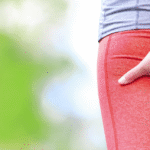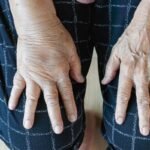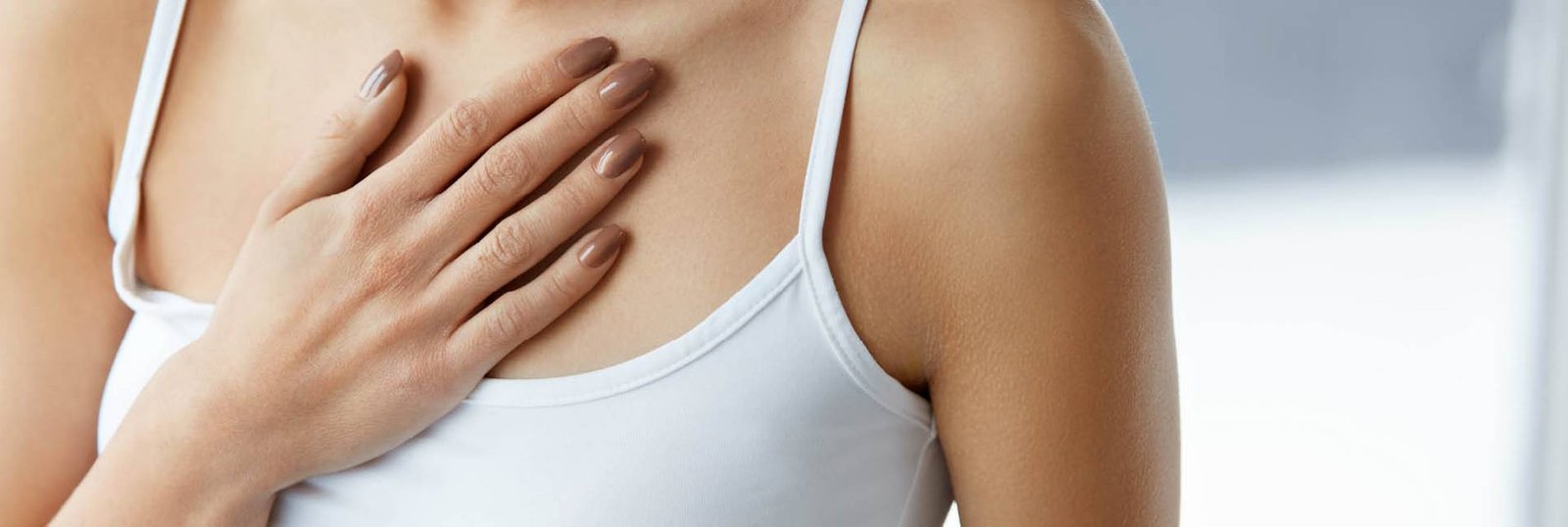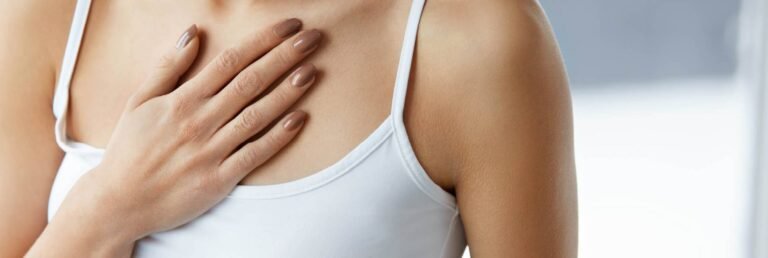Breast pain and the menstrual cycle are often directly related. It’s the most common type of breast pain, affecting more than 70% of women of childbearing age.
This cyclical premenstrual breast pain, medically known as mastodynia, is a consequence of the morphological changes that the breasts undergo with the physiological hormonal fluctuations that occur throughout the cycle.
Specifically, estrogen levels increase from the first day of menstruation until they reach their peak just before the middle of the cycle. This causes the growth of the mammary ducts, the thin tubes in the breast responsible for carrying milk from the lobules of the breast (the gland that produces it) to the nipple.
At the same time, progesterone levels increase during the luteal phase and peak around day 21 of a 28-day cycle. This, in turn, causes the breast lobules (the part of the breast where the lobules are located) to enlarge.
All of this means that the vast majority of women experience breast pain before menstruation.
This breast pain, therefore, is different from any other because it is related to the menstrual cycle. That is, it appears in the luteal phase (generally, the two weeks before the arrival of the period, although it depends on the length of each cycle), increases until the start of menstruation, and improves with the arrival of the period.
Breast pain is usually mild or moderate, but it can be severe in some women. It typically affects both breasts, especially the upper and outer parts, and can extend to the armpits.
This breast pain is often accompanied by swelling, a feeling of heaviness and tension, and/or the formation of lumps (modularity).
It most commonly affects women between the ages of 20 and 45, as well as those in the transition to menopause.
It is also especially common in women with fibrocystic breasts, a benign condition in which the breasts are characterized by thickened breast tissue and fluid-filled cysts.
Likewise, an imbalance of fatty acids within cells can affect the sensitivity of breast tissue to circulating hormones and worsen mastodynia.
Excessive caffeine intake has also been linked to worsening breast pain before menstruation, although more information is needed.
Finally, it has been observed that breast pain tends to be more severe when it coincides with situations of stress and anxiety.
Mastodynia is a benign condition, but it can have a very significant impact on a woman’s quality of life.
Mastodynia can manifest as an isolated symptom and be characterized only as breast pain before menstruation, or it can be one of the manifestations of the so-called premenstrual syndrome.
This disorder is characterized by a set of physical and psychological symptoms that appear days before the arrival of menstruation and that include, beyond mastodynia, abdominal distension, irritability, feelings of sadness, sleep disorders, headaches, and cravings for certain foods, among many others.
In any case, breast pain can significantly affect a woman’s quality of life. However, many women are still unaware of the measures available to relieve breast pain and swelling, and resign themselves to accepting it as part of their menstrual cycle.
It is important to note that women who suffer from mastodynia often have their daily activities limited and tend to suffer from sleep disorders such as insomnia, with effects on their mood.
Those who consult a doctor or pharmacist often do so because breast pain affects their physical or sexual activity. They also fear it could be a possible symptom of breast cancer, which causes them considerable distress and anxiety.
In this sense, it’s important to send a message of reassurance. In breast cancer, breast pain is rarely a warning sign, and if it is, it’s often accompanied by other symptoms: the presence of a new lump in the breast or armpit; a change in the size or shape of the breasts; irritation or indentation of the breast skin; and redness, scaling, indentation, or nipple discharge.
Furthermore, in breast cancer, symptoms such as pain are not influenced by the menstrual cycle and are usually unilateral (affecting only one breast).
Although breast pain is a common complaint and the risk of it being a symptom of breast cancer is low, it should not be underestimated.
Its impact on women’s daily lives can be very negative, and there are currently measures available to alleviate pain and other discomforts.
How to relieve breast pain
When faced with breast pain, it is essential to characterize the symptoms it causes to differentiate it from mastodynia or mastalgia (breast pain unrelated to the menstrual cycle).
The medical history is usually decisive for the diagnosis, but a physical examination is also usually indicated to rule out a physical abnormality.
Once a diagnosis of menstrual-related breast pain has been made, there are several ways to alleviate the symptoms.
· Wear a well-fitting bra . It’s important to wear a properly fitting, supportive bra, as well as a sports bra, when exercising.
· Make dietary changes. Limiting foods high in unhealthy fats and prioritizing those with anti-inflammatory properties (berries, citrus fruits, extra virgin olive oil, omega-3-rich fish, vegetables, etc.) can minimize breast pain before menstruation.
Excess salt intake and high-sodium foods should also be avoided or limited during the luteal phase to reduce bloating.
Another dietary change that some people find helpful is reducing or eliminating caffeine.
· Review your medication use. Some medications can worsen cyclical breast pain. These include those used in fertility treatments, as well as certain antidepressants and antipsychotics.
If breast pain or its worsening is directly related to the use of these medications, you should consult your doctor and consider possible alternatives.
· Apply a breast pain cream . There are breast pain creams that help relieve the discomfort caused by breast tension.
They are not hormonal treatments, but rather contain active ingredients that help improve the symptoms of mastodynia.
Among them, Gossypium herbaceum seed milk , rich in essential fatty acids and phospholipids, and glycyrrhetic acid, with anti-inflammatory properties.
Since they don’t contain hormones, these breast pain creams can be applied whenever necessary. However, it’s recommended to apply them at least twice a day (morning and night), and it’s especially advisable to apply them before bed and leave them on overnight.
The massage performed to achieve absorption of the product also improves drainage and local microcirculation at the cutaneous level.
· Applying cold and heat. Applying cold and heat for breast pain, while having anti-inflammatory and decongestant effects, can also be effective in acute episodes as an adjuvant.
· Turn to herbal medicine . Evening primrose oil supplements can change the fatty acid balance in cells, which could reduce breast pain.
Chasteberry extract ( Vitex agnus castus ) is also commonly used when mastodynia is associated with hormonal changes in women.
· Increase your intake of vitamin E. Several studies have shown a possible beneficial effect of vitamin E for breast pain before menstruation.
In one of them, symptoms of mastodynia improved after taking 200 international units of vitamin E for 2 months.
Foods rich in vitamin E include vegetable oils, nuts, seeds, and green leafy vegetables.
· Start relaxation therapies. Anxiety and breast pain can form a vicious cycle that’s difficult to break. Stress has been linked to a worsening of breast pain, and severe breast tension can, in turn, lead to increased anxiety.
Therefore, any measures that help better manage stress and mood swings will be beneficial for breast pain.
· Use analgesics and anti-inflammatory drugs. When breast pain is severe or very limiting, topical analgesics and anti-inflammatory drugs can also be used.
· Use hormonal treatments. In specific cases, hormonal treatments such as tamoxifen (an anti-estrogen) or danazol (an androgenic) may be indicated. However, these medications are not free of side effects and should never be the first treatment of choice for mastodynia.
Even more so, when there are other effective measures to relieve breast pain without associated risks.
Progesterone can also be prescribed topically, orally, or transdermally. With locally applied progesterone, side effects are virtually nonexistent, and several studies have demonstrated its effectiveness.
All of these measures can be very helpful in managing breast pain during the menstrual cycle. However, if it persists or worsens, it’s important to consult your doctor.




















+ There are no comments
Add yours